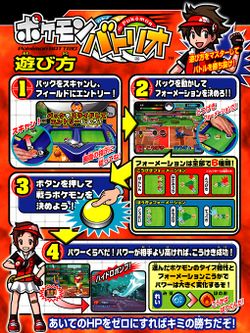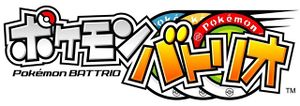No edit summary |
m (Update guide main page) |
||
| (One intermediate revision by one other user not shown) | |||
| Line 1: | Line 1: | ||
{{Header Nav|game=Pokémon Battrio | {{Header Nav|game=Pokémon Battrio}} | ||
{{ | {{Game | ||
|completion=1 | |||
|image=Pokémon Battrio flyer.jpg | |||
|title=Pokémon Battrio | |title=Pokémon Battrio | ||
| | |japanese=ポケモンバトリオ | ||
|developer= | |developer={{colist|Tomy|AQ Interactive}} | ||
|publisher=[[Nintendo]] | |publisher=[[Nintendo]] | ||
| | |year=2007 | ||
| | |systems={{syslist|cade}} | ||
|genre=[[Action]] | |genre=[[Action]] | ||
|players=1-2 | |players=1-2 | ||
|modes=[[Single player]], [[Multiplayer]] | |||
|series=Pokémon | |||
|website=http://battrio.com | |website=http://battrio.com | ||
}} | }} | ||
{{Bulbapedia}} | |||
{{marquee|Pokémon Battrio marquee.jpg}} | {{marquee|Pokémon Battrio marquee.jpg}} | ||
'''Pokémon Battrio''' (ポケモンバトリオ, ''Pokémon Batorio'') is a one- or two-player arcade game released in Japan in 2007. It uses cel-shaded graphics reminiscent of [[The Legend of Zelda: The Wind Waker]]. It is the first and currently only arcade game in the | '''Pokémon Battrio''' (ポケモンバトリオ, ''Pokémon Batorio'') is a one- or two-player arcade game released in Japan in 2007. It uses cel-shaded graphics reminiscent of [[The Legend of Zelda: The Wind Waker]]. It is the first and currently only arcade game in the {{c|Pokémon}} series. It is unknown whether this game will be released outside Japan or on other systems. | ||
The game costs ¥100 per match. In order to play, players must possess specially designed chips resembling [[wp:Pogs|Pogs]]; these can be purchased in randomly assorted packs and also re-used from previous games, just like the cards used by [[Quest of D]]. Like the Pokémon Trading Card Game, each chip depicts a particular Pokémon. | The game costs ¥100 per match. In order to play, players must possess specially designed chips resembling [[wp:Pogs|Pogs]]; these can be purchased in randomly assorted packs and also re-used from previous games, just like the cards used by [[Quest of D]]. Like the Pokémon Trading Card Game, each chip depicts a particular Pokémon. | ||
| Line 22: | Line 25: | ||
The machine only has two buttons per player, but also features two 4×4 grids. Players can place up to three chips on these grids, hence the name Battrio (a contraction of "Battle Trio"); the game then detects their placement and reflects it on the screen. Some arrangements will give bonuses or penalties depending on the Pokémon types used and also the types and arrangements of the Pokémon they are fighting. Moving Pokémon closer to the inside edge puts them in an attack stance, while moving them closer to the outside edge puts them in a defensive role. Combat is turn-based, but unlike most games in the series there is a unified health bar. Each Pokémon still has its own number of hit points (unlike the other games this divided between offensive and defensive health) which then contributes to the total health bar. | The machine only has two buttons per player, but also features two 4×4 grids. Players can place up to three chips on these grids, hence the name Battrio (a contraction of "Battle Trio"); the game then detects their placement and reflects it on the screen. Some arrangements will give bonuses or penalties depending on the Pokémon types used and also the types and arrangements of the Pokémon they are fighting. Moving Pokémon closer to the inside edge puts them in an attack stance, while moving them closer to the outside edge puts them in a defensive role. Combat is turn-based, but unlike most games in the series there is a unified health bar. Each Pokémon still has its own number of hit points (unlike the other games this divided between offensive and defensive health) which then contributes to the total health bar. | ||
{{ToC}} | {{ToC}} | ||
{{Pokémon}} | {{Pokémon}} | ||
[[Category:Nintendo]] | [[Category:Nintendo]] | ||
[[Category:Action]] | [[Category:Action]] | ||
[[Category:Single player]] | [[Category:Single player]] | ||
[[Category:Multiplayer]] | [[Category:Multiplayer]] | ||
Latest revision as of 21:44, 1 April 2023

| Pokémon Battrio | |
|---|---|
| Developer(s) | Tomy, AQ Interactive |
| Publisher(s) | Nintendo |
| Year released | 2007 |
| System(s) | Arcade |
| Series | Pokémon |
| Japanese title | ポケモンバトリオ |
|---|---|
| Genre(s) | Action |
| Players | 1-2 |
| Modes | Single player, Multiplayer |
Pokémon Battrio (ポケモンバトリオ, Pokémon Batorio) is a one- or two-player arcade game released in Japan in 2007. It uses cel-shaded graphics reminiscent of The Legend of Zelda: The Wind Waker. It is the first and currently only arcade game in the Pokémon series. It is unknown whether this game will be released outside Japan or on other systems.
The game costs ¥100 per match. In order to play, players must possess specially designed chips resembling Pogs; these can be purchased in randomly assorted packs and also re-used from previous games, just like the cards used by Quest of D. Like the Pokémon Trading Card Game, each chip depicts a particular Pokémon.
Gameplay[edit]
The machine only has two buttons per player, but also features two 4×4 grids. Players can place up to three chips on these grids, hence the name Battrio (a contraction of "Battle Trio"); the game then detects their placement and reflects it on the screen. Some arrangements will give bonuses or penalties depending on the Pokémon types used and also the types and arrangements of the Pokémon they are fighting. Moving Pokémon closer to the inside edge puts them in an attack stance, while moving them closer to the outside edge puts them in a defensive role. Combat is turn-based, but unlike most games in the series there is a unified health bar. Each Pokémon still has its own number of hit points (unlike the other games this divided between offensive and defensive health) which then contributes to the total health bar.

